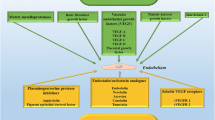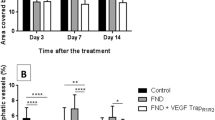Summary
The corneal neovascularization produced by NaOH burns was examined in two groups of pigmented rabbits following laser treatment. The treatment was carried out with energy level 500 mW, spot diameter 200 μm, and exposure time 1 s throughout. In the first group, a single newly formed vessel was coagulated in each case. Subsequent flurescein angiography invariably showed an incomplete occlusion of the vessel. In the second group, we coagulated a section of the neovascularization network at its origin in the corneal limbus. After 48 h, fluorescein perfusion was once again observed, but the vessels involved were predominantly finer than before. Fluorescence microscopy revealed a rich neovascularization of the more superficial layers of the corneal stroma. To be successful, laser treatment must involve both supplying and draining vessels.
Zusammenfassung
An pigmentierten Kaninchen untersuchten wir durch NaOH-Ätzung erzeugte Hornhautgefäßneubildungen nach Laserbehandlung mit konstanten 500 mW Energie, 200 micron spot-Durchmesser und 1 sec Expositionszeit. Bei einer Tiergruppe koagulierten wir jeweils ein einzelnes Gefäß. Fluoreszenzangiographisch erwies sich dieses Gefäß nie als vollständig verschlossen. Bei einer 2. Tiergruppe koagulierten wir an der Basis der vom Limbus netzförmig sich ausbreitenden Neovaskulate. 48 Stunden später waren die Neovaskulate wieder fluoresceindurchgängig; ihre Stämme waren jedoch zarter als zuvor. Fluoreszensmikroskopisch fanden wir reichlich Neovaskularisation insbesondere der oberflächlicheren Stromaschichten. Eine Laserbehandlung von neugebildeten Gefäßen muß die zu-und abführenden Gefäße erfassen, wenn sie erfolgreich sein soll.
Similar content being viewed by others
Literatur
Baurmann, H., Sasaki, K., Schomacher, L., Chioralia, G.: Reactions vasculaires et tissulaires de l'oeil provoquées par la cryocautérisation et par la coagulation au laser. Doc. Ophthal., Proc. ISFA, Ghent,1976, 525–527 (1976)
Cherry, P.M.H., Garner, A.: Corneal neovascularization treated with Argon laser. Brit. J. Ophthal.60, 464–472 (1976)
Ey, R., Hughes, W.F., Bloome, M.A.: Prevention of corneal vascularization. Amer. J. Ophthal.66, 1118–1131 (1968)
Reed, J.W., Fromer, C., Klintworth, G.K.: Induced corneal vascularization remission with Argon laser therapy. A.M.A. Arch. Ophthal.93, 1017–1019 (1975)
Tokumaru, T., Fromer, C.: Herpetic epithelial keratitis: Conditions for photocoagulation treatment by Argon laser as analysed by binding of dye and radiolabeled antiherpes γ-globuline into corneal ulcerus. Ophthalmic Res.7, 181–188 (1975)
Author information
Authors and Affiliations
Additional information
Herrn Prof. Dr. E Weigelin zum 60. Geburtstag
Rights and permissions
About this article
Cite this article
Baurmann, H., Ghioralia, G. & Kremer, F. Rückbildung von cornealen Neovaskulaten durch Laserbehandlung?. Albrecht v Graefes Arch. klin. exp. Ophthal. 204, 45–55 (1977). https://doi.org/10.1007/BF02387416
Received:
Issue Date:
DOI: https://doi.org/10.1007/BF02387416




